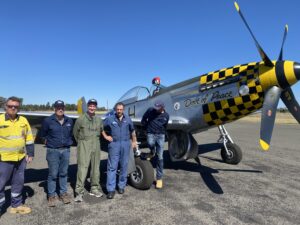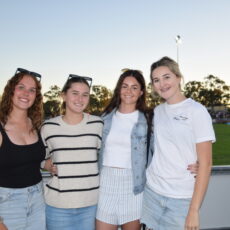A Kittyhawk P40 fighter which once languished in New Guinea jungle after crash landing in 1944 during World War II landed at Narrabri airport on Monday.
The immaculately restored aircraft, 0riginally built in 1943, is owned by Doug Hamilton and is based at Wangaratta.
The ‘Kittyhawk’, accompanied by another classic World War II fighter, a P-51D Mustang, also owned by Doug Hamilton and his Precision Airmotive ‘warbird’ restoration business, landed at Narrabri on their flight home from appearances at the Pacific Air Show on the Gold Coast.
And an extremely rare, restored former German Luftwaffe Focke Wulf 190 fighter, now based at Albury, also touched down at Narrabri enroute to the air show.
Doug Hamilton’s Mustang is a former RAAF aircraft which has been in New Zealand for many years, bought back to Australia by Mr Hamilton.
The P-40 Kittyhawk has had an interesting life, and came with an amazing story of survival.
The Kittyhawk’s journey to Wangaratta began on February 14, 1944 when First Lieutenant Nelson D. Flack, Jr. took off from Gusap Airfield on a fighter sweep over Wewak.
The sequence of subsequent events is described on the Pacific Wrecks website.

Narrabri airport’s Trevor Dean, greeted Precision Airmotive’s Mark Rendell, Steve Bekker, aircraft owner Doug Hamilton and Glenn Bannister with the P-51 D Mustang ‘Dove of Peace’ at Narrabri airport.
“Over the target, Flack broke formation and went after a Ki-61 Tony,” the narrative explains.
“Flack’s fire hit the Japanese fighter, killing the pilot and the Tony crashed into the sea, his second confirmed victory.
“But machine gun fire from the Tony had damaged his cooling system, causing his oil pressure to rise.
“Flack proceeded back towards base alone but had to force land in a field of kunai grass behind enemy lines.
“During the landing, he was knocked unconscious and suffered a broken arm.
“When he awoke he exited the cockpit before the plane caught fire and exploded.
“Immediately after Flack was reported missing, an aerial search was launched and the burning P-40 wreckage was spotted.
“The search pilot saw a grass field suitable for landing about a mile from the crash site.
“In fact, the field was covered with six to eight foot tall kunai grass which caused his aircraft to flip over and broke the propeller.
“The pilot, Salternik was unhurt. He searched for Flack until nightfall, but was unable locate him and remained with his crashed aircraft overnight.
“The next morning, aircraft from Gusap Airfield returned to dropped supplies and equipment to Salternik and told him to stay at the crash site.
“Meanwhile, Lt. Hector Henstridge of the Australian Army 2/7th Commando Company volunteered to parachute down to him, although he had never parachuted before and only flown on an aeroplane once.
“On February 16, 1944 Henstridge parachuted and reached Salternik.
“The next day they located Flack and the three men spent the next two days clearing a landing ground for another aircraft to land and rescue them.

Classic World War 2 fighters a P-40, left, and a P-51D Mustang landed at Narrabri airport on Monday to refuel en route from the Pacific Air Show on the Gold Coast back to their home base at Precision Airmotive, Wangaratta.
“On February 21, 1944, two more aircraft took off from Gusap Airfield in an attempt to land at the landing ground.
“One piloted by James D. Nichols landed successfully but his landing gear went “spread eagle” damaging the airframe and leaving a third person stranded at the site.
“The next, piloted Sgt. Thomas Stallone successfully landed at the clearing, but was unable to take off carrying any additional passengers.
“On the ground, the group of four lead by Henstridge began walking 35 miles in dense jungle to rendezvous with an Australian patrol.
“After departing, aircraft were unable to locate the group and all were declared Missing In Action and the search was abandoned.
On March 3, 1944 after ten days in the jungle, the group ran out of food, forcing them to scrounge nuts and fish from the jungle and streams.
All contracted malaria and lost 20-35 pounds each during the trek.
On March 10, 1944 they encountered an Australian Army patrol, which was pursuing Japanese troops who were also searching for them.
“Taken to a shelter to recover, on March 12, 1944 they were evacuated from Faita Airfield aboard a RAAF Walrus back to Gusap Airfield.
“A RAAF Searcher Team visited the wreckage on May 18, 1946.
“The P-40 was burned around the cockpit and engine, but had otherwise made a good crash landing.
“In early June 2004,the aircraft was recovered with the engine and one wing removed from the crash site, and flown to Madang where it was placed into storage then exported to Australia to Precision Aerospace at Wangaratta Airport.
“The lengthy restoration of some 10 years was completed by Precision Airmotive including a new, original 1942 Allison V12 1250 horsepower engine complete in its box with instructions, and the P40 finally took to the air again on March 3, 2016, with owner Doug Hamilton at the controls.”
To order photos from this page click here










